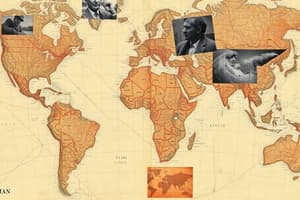Podcast
Questions and Answers
What type of map is primarily designed to show governmental boundaries and locations of various political entities?
What type of map is primarily designed to show governmental boundaries and locations of various political entities?
- Thematic Maps
- Topographic Maps
- Political Maps (correct)
- Physical Maps
Which map type utilizes contour lines to indicate elevation changes and is useful for hikers?
Which map type utilizes contour lines to indicate elevation changes and is useful for hikers?
- Topographic Maps (correct)
- Navigational Maps
- Cadastral Maps
- Choropleth Maps
Choropleth maps are a type of which broader map category?
Choropleth maps are a type of which broader map category?
- Geological Maps
- Cadastral Maps
- Thematic Maps (correct)
- Physical Maps
What type of map is used to visually illustrate the distribution of population using dots?
What type of map is used to visually illustrate the distribution of population using dots?
Which map type offers insights into rock types and geological features?
Which map type offers insights into rock types and geological features?
Flashcards are hidden until you start studying
Study Notes
Types of Maps
-
Political Maps
- Show governmental boundaries.
- Highlight countries, states, and cities.
- Often use different colors to distinguish areas.
-
Physical Maps
- Represent natural landscape features.
- Include mountains, rivers, lakes, and elevation.
- Use color gradients to show terrain elevation.
-
Topographic Maps
- Detailed representation of terrain.
- Use contour lines to indicate elevation changes.
- Useful for hikers and planners for understanding landforms.
-
Thematic Maps
- Focus on specific themes or topics.
- Examples include population density, climate, and economic trends.
- Can be both qualitative and quantitative.
-
Choropleth Maps
- Thematic maps that use color or shading to represent data.
- Often used to visualize demographic information.
- Areas are divided based on statistical variables.
-
Dot Distribution Maps
- Use dots to represent the presence of a feature.
- Each dot corresponds to a specific quantity.
- Helpful in illustrating population distribution.
-
Navigational Maps
- Designed for navigation and travel.
- Include road maps and marine charts.
- Focus on routes, distances, and landmarks.
-
Cadastral Maps
- Show land ownership and property boundaries.
- Useful for real estate and land management.
- Often include details on land usage and zoning.
-
Climate Maps
- Illustrate climate zones and weather patterns.
- Can show average temperature, precipitation, and seasonal variations.
- Important for understanding environmental conditions.
-
Geological Maps
- Represent the distribution of geological features.
- Show rock types, faults, and mineral deposits.
- Useful in the fields of geology and resource management.
Types of Maps Overview
- Maps are categorized into various types based on purpose and content.
Political Maps
- Display governmental boundaries such as countries, states, and cities.
- Use distinct colors to differentiate between various political areas.
Physical Maps
- Show the natural features of the landscape, including mountains, rivers, and lakes.
- Employ color gradients to indicate changes in terrain elevation.
Topographic Maps
- Provide a detailed representation of terrain using contour lines.
- Contour lines show elevation changes, aiding hikers and planners in understanding landforms.
Thematic Maps
- Center around specific themes or topics such as population density and climate.
- Can present data in both qualitative and quantitative forms.
Choropleth Maps
- A subtype of thematic maps that utilize color or shading to depict data.
- Commonly used to visualize demographic information and statistical variables by region.
Dot Distribution Maps
- Utilize dots to signify the presence or quantity of a feature.
- Each dot represents a specific amount, making them effective for illustrating population distribution.
Navigational Maps
- Tailored for navigation and travel purposes, including road and marine charts.
- Focus on routes, distances, and key landmarks important for travelers.
Cadastral Maps
- Show land ownership and property boundaries.
- Valuable for real estate, land management, and include details related to land use and zoning.
Climate Maps
- Illustrate various climate zones and prevailing weather patterns.
- Can depict average temperatures, precipitation levels, and seasonal differences, crucial for environmental understanding.
Geological Maps
- Display the distribution of geological features like rock types, faults, and mineral deposits.
- Serve important functions in geology and resource management discussions.
Studying That Suits You
Use AI to generate personalized quizzes and flashcards to suit your learning preferences.




